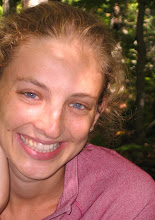Sunday, September 14, 2008
PS122: "The Passion Project"
A ten-by-ten-foot cube in the middle of a dark room acts as the stage for Reid Farrington’s The Passion Project, a half hour long installation which will run through September 20 at PS122. The cube is defined by hanging ropes (these are tied into loops along the perimeter and across the top of the space), several frames holding parchment screens (leaning on the perimeter of the space), and an intermittent square of white light projected onto the floor that appears at the beginning of the performance. The stage awaits dormant, its audience encouraged to walk around it before and during the performance by Mr. Farrington himself. It is reminiscent of a cage, of a room, of a place at once distant and intimate. At times, I felt compelled to enter the stage and experience being inside, rather than outside the cube. But that is the job of Shelley Kay, the live performer who eventually enters the cube, as she said in an interview with Gia Kourlas, “walking into the throngs like a boxer”.
What ensues is an extremely physical half hour, in which Kay lifts, hangs, moves and unhooks the parchment frames from and onto different locations all around the cube. Her challenge is to catch projected images from Carl Th. Dreyer’s 1928 “The Passion of Joan of Arc”, a classic black and white silent film on the story of Joan of Arc’s condemnation and eventual death as a martyr. The film has been cut and edited by Farrington, so that for the most part what appears on the screens are close ups of different characters: Joan of Arc, of course, as well as various representatives of the orthodox clergy that broke her with long interrogations and finally had her burned. Kay moves frantically around the cube, catching an image of Joan of Arc, and letting her hang onto a loop, then running in a diagonal for the close up of a clergy man—this only lasts a few moments, than Kay kneels, puts down the frame she’s holding, and grabs another to run onto the next projection. The effect is powerful: the frames become windows, shields, tools, all necessary to piece together Joan of Arc’s story. As the performance builds up, Kay begins to sweat, her effort contrasting her physical presence with the mediated presence of the actors all around her. While we watch Kay catching images and working hard on keeping up with her cues, Farrington also stands on the side, watching. Like the men in the film, and like us spectators, only witnesses Kay’s efforts and physical challenges. An interesting echo to the projections of the clergymen on the screen.
The powerful visuals of The Passion Project are enhanced by Farrington’s sound design, a multi-layered mixture of church chants, the sound of the film’s reel being projected, the voices of people editing the film, as well as some less recognizable voices and noises. The volume of the sound sometimes reaches almost unbearable loudness, creating a physical and emotional experience for the audience. The parchment screens themselves create loud snaps every time Kay reaches out to catch an image. Like the projections on the screens, the sound is not continuous, but has a repetitive quality to it. The overall effect is a three dimensional puzzle coming together, a puzzle with many layers and not definitive form.
Farrington’s piece successfully brings the audience into the nightmare of Joan of Arc, while taking a step back from film as a medium of representation. Through Kay’s performance, Farrington breaks down and exposes the different frames from the film: Kay is literally piecing the film together. By the end of the installation, the film has become at once more and less than itself, a combination of live performance, sound art, and clips of the original film. There were moments when I wished for more distance, more ambiguity towards the inevitably tragic nature of the story. My desire might have been encouraged by almost unidentifiable moments of humor in the installation (for instance, when Joan of Arc is being burned and on one of the screens there appears: “Jesus!”). Kay’s performance, although based on cues and tasks, sometimes overly amplified the evident suffering already on display in the projections of Joan of Arc. Yet overall the piece opened up the original film in unexpected ways, the installation offering a perfect medium through which to present the work. Anyone interested in video, dance, or installation performance should not miss Farrington's latest work.
Subscribe to:
Post Comments (Atom)


No comments:
Post a Comment